Spintronics Based Terahertz Sources
Abstract
1. Introduction
2. Mechanism of THz Emission from Spintronic THz Sources
3. Experimental Setup for Spintronic THz Sources
3.1. Terahertz Time-Domain Spectroscopy
3.2. Typical THz-Emission Signals from Spintronic THz Sources
4. Performance Optimization of Spintronic THz Sources
4.1. Optimizing Materials
4.2. Optimizing Thickness
4.3. Optimizing Structures
5. Manipulation of Terahertz Emission by Spintronic THz Sources
5.1. Magnetic-Field Manipulation
5.2. Electric-Field Manipulation
6. Applications of Spintronic THz Sources
6.1. Broadband THz Spectroscopy

6.2. THz Imaging
7. Conclusions
Author Contributions
Funding
Institutional Review Board Statement
Informed Consent Statement
Data Availability Statement
Acknowledgments
Conflicts of Interest
References
- Ferguson, B.; Zhang, X.C. Materials for Terahertz Science and Technology. Nat. Mater. 2002, 1, 26–33. [Google Scholar] [CrossRef] [PubMed]
- Tonouchi, M. Cutting-Edge Terahertz Technology. Nat. Photonics 2007, 1, 97–105.003C003E. [Google Scholar] [CrossRef]
- Basov, D.N.; Averitt, R.D.; van der Marel, D.; Dressel, M.; Haule, K. Electrodynamics of Correlated Electron Materials. Rev. Mod. Phys. 2011, 83, 471–541. [Google Scholar] [CrossRef]
- Kampfrath, T.; Tanaka, K.; Nelson, K.A. Resonant and Nonresonant Control over Matter and Light by Intense Terahertz Transients. Nat. Photonics 2013, 7, 680–690. [Google Scholar] [CrossRef]
- Hangyo, M.; Tani, M.; Nagashima, T. Terahertz Time-Domain Spectroscopy of Solids: A Review. Int. J. Infrared Millim. Waves 2005, 26, 1661–1690. [Google Scholar] [CrossRef]
- Koenig, S.; Lopez-Diaz, D.; Antes, J.; Boes, F.; Henneberger, R.; Leuther, A.; Tessmann, A.; Schmogrow, R.; Hillerkuss, D.; Palmer, R.; et al. Wireless Sub-THz Communication System with High Data Rate. Nat. Photonics 2013, 7, 977–981. [Google Scholar] [CrossRef]
- Federici, J.; Moeller, L. Review of Terahertz and Subterahertz Wireless Communications. J. Appl. Phys. 2010, 107, 111101. [Google Scholar] [CrossRef]
- Pickwell, E.; Wallace, V.P. Biomedical Applications of Terahertz Technology. J. Phys. D Appl. Phys. 2006, 39, R301–R310. [Google Scholar] [CrossRef]
- Jepsen, P.U.; Cooke, D.G.; Koch, M. Terahertz Spectroscopy and Imaging-Modern Techniques and Applications. Laser Photon. Rev. 2011, 5, 124–166. [Google Scholar] [CrossRef]
- Rice, A.; Jin, Y.; Ma, X.F.; Zhang, X.C.; Bliss, D.; Larkin, J.; Alexander, M. Terahertz Optical Rectification from 〈110〉 Zinc-blende Crystals. Appl. Phys. Lett. 1994, 64, 1324–1326. [Google Scholar] [CrossRef]
- Kawase, K.; Sato, M.; Taniuchi, T.; Ito, H. Coherent Tunable THz-wave Generation from LiNbO 3 with Monolithic Grating Coupler. Appl. Phys. Lett. 1996, 68, 2483–2485. [Google Scholar] [CrossRef]
- Hoffmann, M.C.; Yeh, K.-L.; Hebling, J.; Nelson, K.A. Efficient Terahertz Generation by Optical Rectification at 1035 Nm. Opt. Express 2007, 15, 11706. [Google Scholar] [CrossRef] [PubMed]
- Auston, D.H.; Cheung, K.P.; Smith, P.R. Picosecond Photoconducting Hertzian Dipoles. Appl. Phys. Lett. 1984, 45, 284–286. [Google Scholar] [CrossRef]
- Lepeshov, S.; Gorodetsky, A.; Krasnok, A.; Rafailov, E.; Belov, P. Enhancement of Terahertz Photoconductive Antenna Operation by Optical Nanoantennas. Laser Photon. Rev. 2017, 11, 1600199. [Google Scholar] [CrossRef]
- Zhong, H.; Karpowicz, N.; Zhang, X.C. Terahertz Emission Profile from Laser-Induced Air Plasma. Appl. Phys. Lett. 2006, 88, 261103. [Google Scholar] [CrossRef]
- Xie, X.; Dai, J.; Zhang, X.C. Coherent Control of THz Wave Generation in Ambient Air. Phys. Rev. Lett. 2006, 96, 075005. [Google Scholar] [CrossRef] [PubMed]
- Blanchard, F.; Sharma, G.; Razzari, L.; Ropagnol, X.; Bandulet, H.-C.; Vidal, F.; Morandotti, R.; Kieffer, J.-C.; Ozaki, T.; Tiedje, H.; et al. Generation of Intense Terahertz Radiation via Optical Methods. IEEE J. Sel. Top. Quantum Electron. 2011, 17, 5–16. [Google Scholar] [CrossRef]
- Roskos, H.G.; Thomson, M.D.; Kreß, M.; Löffler, T. Broadband THz Emission from Gas Plasmas Induced by Femtosecond Optical Pulses: From Fundamentals to Applications. Laser Photonics Rev. 2007, 1, 349–368. [Google Scholar] [CrossRef]
- Beaurepaire, E.; Turner, G.M.; Harrel, S.M.; Beard, M.C.; Bigot, J.Y.; Schmuttenmaer, C.A. Coherent Terahertz Emission from Ferromagnetic Films Excited by Femtosecond Laser Pulses. Appl. Phys. Lett. 2004, 84, 3465–3467. [Google Scholar] [CrossRef]
- Kampfrath, T.; Battiato, M.; Maldonado, P.; Eilers, G.; Nötzold, J.; Mährlein, S.; Zbarsky, V.; Freimuth, F.; Mokrousov, Y.; Blügel, S.; et al. Terahertz Spin Current Pulses Controlled by Magnetic Heterostructures. Nat. Nanotechnol. 2013, 8, 256–260. [Google Scholar] [CrossRef]
- Seifert, T.; Jaiswal, S.; Martens, U.; Hannegan, J.; Braun, L.; Maldonado, P.; Freimuth, F.; Kronenberg, A.; Henrizi, J.; Radu, I.; et al. Efficient Metallic Spintronic Emitters of Ultrabroadband Terahertz Radiation. Nat. Photonics 2016, 10, 483–488. [Google Scholar] [CrossRef]
- Jackson, J.D. Classical Electrodynamics; Springer: Berlin/Heidelberg, Germany, 1999. [Google Scholar]
- Beaurepaire, E.; Merle, J.-C.; Daunois, A.; Bigot, J.-Y. Ultrafast Spin Dynamics in Ferromagnetic Nickel. Phys. Rev. Lett. 1996, 76, 4250–4253. [Google Scholar] [CrossRef] [PubMed]
- Huang, L.; Lee, S.-H.; Kim, S.-D.; Shim, J.-H.; Shin, H.J.; Kim, S.; Park, J.; Park, S.-Y.; Choi, Y.S.; Kim, H.-J.; et al. Universal Field-Tunable Terahertz Emission by Ultrafast Photoinduced Demagnetization in Fe, Ni, and Co Ferromagnetic Films. Sci. Rep. 2020, 10, 15843. [Google Scholar] [CrossRef] [PubMed]
- Venkatesh, M.; Ramakanth, S.; Chaudhary, A.K.; Raju, K.C.J. Study of Terahertz Emission from Nickel (Ni) Films of Different Thicknesses Using Ultrafast Laser Pulses. Opt. Mater. Express 2016, 6, 2342. [Google Scholar] [CrossRef]
- Kimel, A.V.; Kirilyuk, A.; Tsvetkov, A.; Pisarev, R.V.; Rasing, T. Laser-Induced Ultrafast Spin Reorientation in the Antiferromagnet TmFeO3. Nature 2004, 429, 850–853. [Google Scholar] [CrossRef]
- Yamaguchi, K.; Kurihara, T.; Minami, Y.; Nakajima, M.; Suemoto, T. Terahertz Time-Domain Observation of Spin Reorientation in Orthoferrite ErFeO3 through Magnetic Free Induction Decay. Phys. Rev. Lett. 2013, 110, 137204. [Google Scholar] [CrossRef]
- Mikhaylovskiy, R.V.; Hendry, E.; Kruglyak, V.V.; Pisarev, R.V.; Rasing, T.; Kimel, A.V. Terahertz Emission Spectroscopy of Laser-Induced Spin Dynamics in TmFeO3 and ErFeO3 Orthoferrites. Phys. Rev. B 2014, 90, 184405. [Google Scholar] [CrossRef]
- Khusyainov, D.; Ovcharenko, S.; Gaponov, M.; Buryakov, A.; Klimov, A.; Tiercelin, N.; Pernod, P.; Nozdrin, V.; Mishina, E.; Sigov, A.; et al. Polarization Control of THz Emission Using Spin-Reorientation Transition in Spintronic Heterostructure. Sci. Rep. 2021, 11, 697. [Google Scholar] [CrossRef]
- Hirsch, J.E. Spin Hall Effect. Phys. Rev. Lett. 1999, 83, 1834–1837. [Google Scholar] [CrossRef]
- Sinova, J.; Valenzuela, S.O.; Wunderlich, J.; Back, C.H.; Jungwirth, T. Spin Hall Effects. Rev. Mod. Phys. 2015, 87, 1213–1260. [Google Scholar] [CrossRef]
- Hoffmann, A. Spin Hall Effects in Metals. IEEE Trans. Magn. 2013, 49, 5172–5193. [Google Scholar] [CrossRef]
- Jungwirth, T.; Wunderlich, J.; Olejník, K. Spin Hall Effect Devices. Nat. Mater. 2012, 11, 382–390. [Google Scholar] [CrossRef] [PubMed]
- Lesne, E.; Fu, Y.; Oyarzun, S.; Rojas-Sánchez, J.C.; Vaz, D.C.; Naganuma, H.; Sicoli, G.; Attané, J.P.; Jamet, M.; Jacquet, E.; et al. Highly Efficient and Tunable Spin-to-Charge Conversion through Rashba Coupling at Oxide Interfaces. Nat. Mater. 2016, 15, 1261–1266. [Google Scholar] [CrossRef]
- Manchon, A.; Koo, H.C.; Nitta, J.; Frolov, S.M.; Duine, R.A. New Perspectives for Rashba Spin–Orbit Coupling. Nat. Mater. 2015, 14, 871–882. [Google Scholar] [CrossRef]
- Jungfleisch, M.B.; Zhang, Q.; Zhang, W.; Pearson, J.E.; Schaller, R.D.; Wen, H.; Hoffmann, A. Control of Terahertz Emission by Ultrafast Spin-Charge Current Conversion at Rashba Interfaces. Phys. Rev. Lett. 2018, 120, 207207. [Google Scholar] [CrossRef] [PubMed]
- Zhou, C.; Liu, Y.P.; Wang, Z.; Ma, S.J.; Jia, M.W.; Wu, R.Q.; Zhou, L.; Zhang, W.; Liu, M.K.; Wu, Y.Z.; et al. Broadband Terahertz Generation via the Interface Inverse Rashba-Edelstein Effect. Phys. Rev. Lett. 2018, 121, 086801. [Google Scholar] [CrossRef]
- Seifert, T.S.; Jaiswal, S.; Barker, J.; Weber, S.T.; Razdolski, I.; Cramer, J.; Gueckstock, O.; Maehrlein, S.F.; Nadvornik, L.; Watanabe, S.; et al. Femtosecond Formation Dynamics of the Spin Seebeck Effect Revealed by Terahertz Spectroscopy. Nat. Commun. 2018, 9, 2899. [Google Scholar] [CrossRef]
- Uchida, K.; Takahashi, S.; Harii, K.; Ieda, J.; Koshibae, W.; Ando, K.; Maekawa, S.; Saitoh, E. Observation of the Spin Seebeck Effect. Nature 2008, 455, 778–781. [Google Scholar] [CrossRef]
- Qu, D.; Huang, S.Y.; Hu, J.; Wu, R.; Chien, C.L. Intrinsic Spin Seebeck Effect in Au/YIG. Phys. Rev. Lett. 2013, 110, 067206. [Google Scholar] [CrossRef]
- Qiu, H.; Zhou, L.; Zhang, C.; Wu, J.; Tian, Y.; Cheng, S.; Mi, S.; Zhao, H.; Zhang, Q.; Wu, D.; et al. Ultrafast Spin Current Generated from an Antiferromagnet. Nat. Phys. 2021, 17, 388–394. [Google Scholar] [CrossRef]
- Zhang, Q.; Luo, Z.; Li, H.; Yang, Y.; Zhang, X.; Wu, Y. Terahertz Emission from Anomalous Hall Effect in a Single-Layer Ferromagnet. Phys. Rev. Appl. 2019, 12, 054027. [Google Scholar] [CrossRef]
- Neu, J.; Schmuttenmaer, C.A. Tutorial: An Introduction to Terahertz Time Domain Spectroscopy (THz-TDS). J. Appl. Phys. 2018, 124, 231101. [Google Scholar] [CrossRef]
- Torosyan, G.; Keller, S.; Scheuer, L.; Beigang, R.; Papaioannou, E.T. Optimized Spintronic Terahertz Emitters Based on Epitaxial Grown Fe/Pt Layer Structures. Sci. Rep. 2018, 8, 1311. [Google Scholar] [CrossRef] [PubMed]
- Herapath, R.I.; Hornett, S.M.; Seifert, T.S.; Jakob, G.; Kläui, M.; Bertolotti, J.; Kampfrath, T.; Hendry, E. Impact of Pump Wavelength on Terahertz Emission of a Cavity-Enhanced Spintronic Trilayer. Appl. Phys. Lett. 2019, 114, 041107. [Google Scholar] [CrossRef]
- Yang, D.; Liang, J.; Zhou, C.; Sun, L.; Zheng, R.; Luo, S.; Wu, Y.; Qi, J. Powerful and Tunable THz Emitters Based on the Fe/Pt Magnetic Heterostructure. Adv. Opt. Mater. 2016, 4, 1944–1949. [Google Scholar] [CrossRef]
- Wu, Y.; Elyasi, M.; Qiu, X.; Chen, M.; Liu, Y.; Ke, L.; Yang, H. High-Performance THz Emitters Based on Ferromagnetic/Nonmagnetic Heterostructures. Adv. Mater. 2017, 29, 1603031. [Google Scholar] [CrossRef]
- Sasaki, Y.; Suzuki, K.Z.; Mizukami, S. Annealing Effect on Laser Pulse-Induced THz Wave Emission in Ta/CoFeB/MgO Films. Appl. Phys. Lett. 2017, 111, 102401. [Google Scholar] [CrossRef]
- Li, G.; Medapalli, R.; Mikhaylovskiy, R.V.; Spada, F.E.; Rasing, T.; Fullerton, E.E.; Kimel, A.V. THz Emission from Co/Pt Bilayers with Varied Roughness, Crystal Structure, and Interface Intermixing. Phys. Rev. Mater. 2019, 3, 084415. [Google Scholar] [CrossRef]
- Sasaki, Y.; Kota, Y.; Iihama, S.; Suzuki, K.Z.; Sakuma, A.; Mizukami, S. Effect of Co and Fe Stoichiometry on Terahertz Emission from Ta/(CoxFe1−x)80B20/MgO. Phys. Rev. B 2019, 100, 140406. [Google Scholar] [CrossRef]
- Nenno, D.M.; Scheuer, L.; Sokoluk, D.; Keller, S.; Torosyan, G.; Brodyanski, A.; Lösch, J.; Battiato, M.; Rahm, M.; Binder, R.H.; et al. Modification of Spintronic Terahertz Emitter Performance through Defect Engineering. Sci. Rep. 2019, 9, 13348. [Google Scholar] [CrossRef]
- Panahi, O.; Yahyaei, B.; Mousavi, S.M.; Ghiasabadi, A.M. High Performance Terahertz Emitter Based on Inverse Spin Hall Effect in Metallic Fe/Au Heterostructure. Laser Phys. 2020, 30, 055001. [Google Scholar] [CrossRef]
- Zhang, S.; Jin, Z.; Zhu, Z.; Zhu, W.; Zhang, Z.; Ma, G.; Yao, J. Bursts of Efficient Terahertz Radiation with Saturation Effect from Metal-Based Ferromagnetic Heterostructures. J. Phys. D Appl. Phys. 2018, 51, 034001. [Google Scholar] [CrossRef]
- Zhang, H.; Feng, Z.; Zhang, J.; Bai, H.; Yang, H.; Cai, J.; Zhao, W.; Tan, W.; Hu, F.; Shen, B.; et al. Laser Pulse Induced Efficient Terahertz Emission from Co/Al Heterostructures. Phys. Rev. B 2020, 102, 024435. [Google Scholar] [CrossRef]
- Li, C.; Fang, B.; Zhang, L.; Chen, Q.; Xie, X.; Xu, N.; Zeng, Z.; Wang, Z.; Fang, L.; Jiang, T. Terahertz Generation via Picosecond Spin-to-Charge Conversion in IrMn3/Ni–Fe Heterojunction. Phys. Rev. Appl. 2021, 16, 024058. [Google Scholar] [CrossRef]
- Ni, Y.; Jin, Z.; Song, B.; Zhou, X.; Chen, H.; Song, C.; Peng, Y.; Zhang, C.; Pan, F.; Ma, G.; et al. Temperature-Dependent Terahertz Emission from Co/Mn2Au Spintronic Bilayers. Phys. Status Solidi Rapid Res. Lett. 2021, 15, 2100290. [Google Scholar] [CrossRef]
- Bierhance, G.; Markou, A.; Gueckstock, O.; Rouzegar, R.; Behovits, Y.; Chekhov, A.L.; Wolf, M.; Seifert, T.S.; Felser, C.; Kampfrath, T. Spin-Voltage-Driven Efficient Terahertz Spin Currents from the Magnetic Weyl Semimetals Co 2 MnGa and Co 2 MnAl. Appl. Phys. Lett. 2022, 120, 082401. [Google Scholar] [CrossRef]
- Hawecker, J.; Rongione, E.; Markou, A.; Krishnia, S.; Godel, F.; Collin, S.; Lebrun, R.; Tignon, J.; Mangeney, J.; Boulier, T.; et al. Spintronic THz Emitters Based on Transition Metals and Semi-Metals/Pt Multilayers. Appl. Phys. Lett. 2022, 120, 122406. [Google Scholar] [CrossRef]
- Heidtfeld, S.; Adam, R.; Kubota, T.; Takanashi, K.; Cao, D.; Schmitz-Antoniak, C.; Bürgler, D.E.; Wang, F.; Greb, C.; Chen, G.; et al. Generation of Terahertz Transients from Co2Fe0.4Mn0.6Si-Heusler-Alloy/Normal-Metal Nanobilayers Excited by Femtosecond Optical Pulses. Phys. Rev. Res. 2021, 3, 043025. [Google Scholar] [CrossRef]
- Khang, N.H.D.; Ueda, Y.; Hai, P.N. A Conductive Topological Insulator with Large Spin Hall Effect for Ultralow Power Spin–Orbit Torque Switching. Nat. Mater. 2018, 17, 808–813. [Google Scholar] [CrossRef]
- Hasan, M.Z.; Kane, C.L. Colloquium: Topological Insulators. Rev. Mod. Phys. 2010, 82, 3045–3067. [Google Scholar] [CrossRef]
- Wang, X.; Cheng, L.; Zhu, D.; Wu, Y.; Chen, M.; Wang, Y.; Zhao, D.; Boothroyd, C.B.; Lam, Y.M.; Zhu, J.X.; et al. Ultrafast Spin-to-Charge Conversion at the Surface of Topological Insulator Thin Films. Adv. Mater. 2018, 30, 1802356. [Google Scholar] [CrossRef] [PubMed]
- Tong, M.; Hu, Y.; Wang, Z.; Zhou, T.; Xie, X.; Cheng, X.; Jiang, T. Enhanced Terahertz Radiation by Efficient Spin-to-Charge Conversion in Rashba-Mediated Dirac Surface States. Nano Lett. 2021, 21, 60–67. [Google Scholar] [CrossRef] [PubMed]
- Park, H.; Jeong, K.; Maeng, I.H.; Sim, K.I.; Pathak, S.; Kim, J.; Hong, S.B.; Jung, T.S.; Kang, C.; Kim, J.H.; et al. Enhanced Spin-to-Charge Conversion Efficiency in Ultrathin Bi2Se3 Observed by Spintronic Terahertz Spectroscopy. ACS Appl. Mater. Interfaces 2021, 13, 23153–23160. [Google Scholar] [CrossRef] [PubMed]
- Park, H.; Rho, S.; Kim, J.; Kim, H.; Kim, D.; Kang, C.; Cho, M. Topological Surface-Dominated Spintronic THz Emission in Topologically Nontrivial Bi1− x Sbx Films. Adv. Sci. 2022, 9, 2200948. [Google Scholar] [CrossRef]
- Cheng, L.; Wang, X.; Yang, W.; Chai, J.; Yang, M.; Chen, M.; Wu, Y.; Chen, X.; Chi, D.; Goh, K.E.J.; et al. Far Out-of-Equilibrium Spin Populations Trigger Giant Spin Injection into Atomically Thin MoS2. Nat. Phys. 2019, 15, 347–351. [Google Scholar] [CrossRef]
- Cong, K.; Vetter, E.; Yan, L.; Li, Y.; Zhang, Q.; Xiong, Y.; Qu, H.; Schaller, R.D.; Hoffmann, A.; Kemper, A.F.; et al. Coherent Control of Asymmetric Spintronic Terahertz Emission from Two-Dimensional Hybrid Metal Halides. Nat. Commun. 2021, 12, 5744. [Google Scholar] [CrossRef] [PubMed]
- Seifert, T.S.; Tran, N.M.; Gueckstock, O.; Rouzegar, S.M.; Nadvornik, L.; Jaiswal, S.; Jakob, G.; Temnov, V.V.; Münzenberg, M.; Wolf, M.; et al. Terahertz Spectroscopy for All-Optical Spintronic Characterization of the Spin-Hall-Effect Metals Pt, W and Cu 80 Ir 20. J. Phys. D Appl. Phys. 2018, 51, 364003. [Google Scholar] [CrossRef]
- Feng, Z.; Yu, R.; Zhou, Y.; Lu, H.; Tan, W.; Deng, H.; Liu, Q.; Zhai, Z.; Zhu, L.; Cai, J.; et al. Highly Efficient Spintronic Terahertz Emitter Enabled by Metal–Dielectric Photonic Crystal. Adv. Opt. Mater. 2018, 6, 1800965. [Google Scholar] [CrossRef]
- Jin, Z.; Peng, Y.; Ni, Y.; Wu, G.; Ji, B.; Wu, X.; Zhang, Z.; Ma, G.; Zhang, C.; Chen, L.; et al. Cascaded Amplification and Manipulation of Terahertz Emission by Flexible Spintronic Heterostructures. Laser Photon. Rev. 2022, 16, 2100688. [Google Scholar] [CrossRef]
- Nandi, U.; Abdelaziz, M.S.; Jaiswal, S.; Jakob, G.; Gueckstock, O.; Rouzegar, S.M.; Seifert, T.S.; Kläui, M.; Kampfrath, T.; Preu, S. Antenna-Coupled Spintronic Terahertz Emitters Driven by a 1550 Nm Femtosecond Laser Oscillator. Appl. Phys. Lett. 2019, 115, 022405. [Google Scholar] [CrossRef]
- Shahriar, B.Y.; Carnio, B.N.; Hopmann, E.; Elezzabi, A.Y. Enhanced Directive Terahertz Radiation Emission from a Horn Antenna-Coupled W/Fe/Pt Spintronic Film Stack. Appl. Phys. Lett. 2021, 119, 092402. [Google Scholar] [CrossRef]
- Hoppe, W.; Weber, J.; Tirpanci, S.; Gueckstock, O.; Kampfrath, T.; Woltersdorf, G. On-Chip Generation of Ultrafast Current Pulses by Nanolayered Spintronic Terahertz Emitters. ACS Appl. Nano Mater. 2021, 4, 7454–7460. [Google Scholar] [CrossRef]
- Chen, M.; Wu, Y.; Liu, Y.; Lee, K.; Qiu, X.; He, P.; Yu, J.; Yang, H. Current-Enhanced Broadband THz Emission from Spintronic Devices. Adv. Opt. Mater. 2018, 7, 1801608. [Google Scholar] [CrossRef]
- Liu, S.; Guo, F.; Li, P.; Wei, G.; Wang, C.; Chen, X.; Wang, B.; Zhao, W.; Miao, J.; Wang, L.; et al. Nanoplasmonic-Enhanced Spintronic Terahertz Emission. Adv. Mater. Interfaces 2022, 9, 2101296. [Google Scholar] [CrossRef]
- Hibberd, M.T.; Lake, D.S.; Johansson, N.A.B.; Thomson, T.; Jamison, S.P.; Graham, D.M. Magnetic-Field Tailoring of the Terahertz Polarization Emitted from a Spintronic Source. Appl. Phys. Lett. 2019, 114, 031101. [Google Scholar] [CrossRef]
- Gueckstock, O.; Nádvorník, L.; Seifert, T.S.; Borchert, M.; Jakob, G.; Schmidt, G.; Woltersdorf, G.; Kläui, M.; Wolf, M.; Kampfrath, T. Modulating the Polarization of Broadband Terahertz Pulses from a Spintronic Emitter at Rates up to 10 KHz. Optica 2021, 8, 1013. [Google Scholar] [CrossRef]
- Agarwal, P.; Huang, L.; Ter Lim, S.; Singh, R. Electric-Field Control of Nonlinear THz Spintronic Emitters. Nat. Commun. 2022, 13, 4072. [Google Scholar] [CrossRef]
- Kong, D.; Wu, X.; Wang, B.; Nie, T.; Xiao, M.; Pandey, C.; Gao, Y.; Wen, L.; Zhao, W.; Ruan, C.; et al. Broadband Spintronic Terahertz Emitter with Magnetic-Field Manipulated Polarizations. Adv. Opt. Mater. 2019, 7, 1900487. [Google Scholar] [CrossRef]
- Chen, X.; Wu, X.; Shan, S.; Guo, F.; Kong, D.; Wang, C.; Nie, T.; Pandey, C.; Wen, L.; Zhao, W.; et al. Generation and Manipulation of Chiral Broadband Terahertz Waves from Cascade Spintronic Terahertz Emitters. Appl. Phys. Lett. 2019, 115, 221104. [Google Scholar] [CrossRef]
- Cheng, H.; Huang, Q.; He, H.; Zhao, Z.; Sun, H.; Wu, Q.; Jiang, Z.; Wang, J.; Huang, H.; Fu, Z.; et al. Giant Electrical Modulation of Terahertz Emission in Pb(Mg1/3Nb2/3)0.7Ti0.3O3/Co-Fe-B/Pt. Phys. Rev. Appl. 2021, 16, 054011. [Google Scholar] [CrossRef]
- Khusyainov, D.; Ovcharenko, S.; Buryakov, A.; Klimov, A.; Pernod, P.; Nozdrin, V.; Mishina, E.; Sigov, A.; Preobrazhensky, V.; Tiercelin, N. Composite Multiferroic Terahertz Emitter: Polarization Control via an Electric Field. Phys. Rev. Appl. 2022, 17, 044025. [Google Scholar] [CrossRef]
- Seifert, T.; Jaiswal, S.; Sajadi, M.; Jakob, G.; Winnerl, S.; Wolf, M.; Kläui, M.; Kampfrath, T. Ultrabroadband Single-Cycle Terahertz Pulses with Peak Fields of 300 KV Cm −1 from a Metallic Spintronic Emitter. Appl. Phys. Lett. 2017, 110, 252402. [Google Scholar] [CrossRef]
- Milot, R.L.; Klug, M.T.; Davies, C.L.; Wang, Z.; Kraus, H.; Snaith, H.J.; Johnston, M.B.; Herz, L.M. The Effects of Doping Density and Temperature on the Optoelectronic Properties of Formamidinium Tin Triiodide Thin Films. Adv. Mater. 2018, 30, 1804506. [Google Scholar] [CrossRef] [PubMed]
- Bai, Z.; Liu, Y.; Kong, R.; Nie, T.; Sun, Y.; Li, H.; Sun, T.; Pandey, C.; Wang, Y.; Zhang, H.; et al. Near-Field Terahertz Sensing of HeLa Cells and Pseudomonas Based on Monolithic Integrated Metamaterials with a Spintronic Terahertz Emitter. ACS Appl. Mater. Interfaces 2020, 12, 35895–35902. [Google Scholar] [CrossRef] [PubMed]
- Balos, V.; Müller, P.; Jakob, G.; Kläui, M.; Sajadi, M. Imprinting the Complex Dielectric Permittivity of Liquids into the Spintronic Terahertz Emission. Appl. Phys. Lett. 2021, 119, 091104. [Google Scholar] [CrossRef]
- Cheng, L.; Li, Z.; Zhao, D.; Chia, E.E.M. Studying Spin–Charge Conversion Using Terahertz Pulses. APL Mater. 2021, 9, 070902. [Google Scholar] [CrossRef]
- Müller, M.; Martín Sabanés, N.; Kampfrath, T.; Wolf, M. Phase-Resolved Detection of Ultrabroadband THz Pulses inside a Scanning Tunneling Microscope Junction. ACS Photonics 2020, 7, 2046–2055. [Google Scholar] [CrossRef]
- Chen, S.-C.; Feng, Z.; Li, J.; Tan, W.; Du, L.-H.; Cai, J.; Ma, Y.; He, K.; Ding, H.; Zhai, Z.-H.; et al. Ghost Spintronic THz-Emitter-Array Microscope. Light Sci. Appl. 2020, 9, 99. [Google Scholar] [CrossRef]
- Bulgarevich, D.S.; Akamine, Y.; Talara, M.; Mag-usara, V.; Kitahara, H.; Kato, H.; Shiihara, M.; Tani, M.; Watanabe, M. Terahertz Magneto-Optic Sensor/Imager. Sci. Rep. 2020, 10, 1158. [Google Scholar] [CrossRef]
- Guo, F.; Pandey, C.; Wang, C.; Nie, T.; Wen, L.; Zhao, W.; Miao, J.; Wang, L.; Wu, X. Generation of Highly Efficient Terahertz Radiation in Ferromagnetic Heterostructures and Its Application in Spintronic Terahertz Emission Microscopy (STEM). OSA Contin. 2020, 3, 893. [Google Scholar] [CrossRef]
- Stiewe, F.-F.; Winkel, T.; Sasaki, Y.; Tubandt, T.; Kleinke, T.; Denker, C.; Martens, U.; Meyer, N.; Parvini, T.S.; Mizukami, S.; et al. Spintronic Emitters for Super-Resolution in THz-Spectral Imaging. Appl. Phys. Lett. 2022, 120, 032406. [Google Scholar] [CrossRef]
- Agarwal, P.; Yang, Y.; Lourembam, J.; Medwal, R.; Battiato, M.; Singh, R. Terahertz Spintronic Magnetometer (TSM). Appl. Phys. Lett. 2022, 120, 161104. [Google Scholar] [CrossRef]
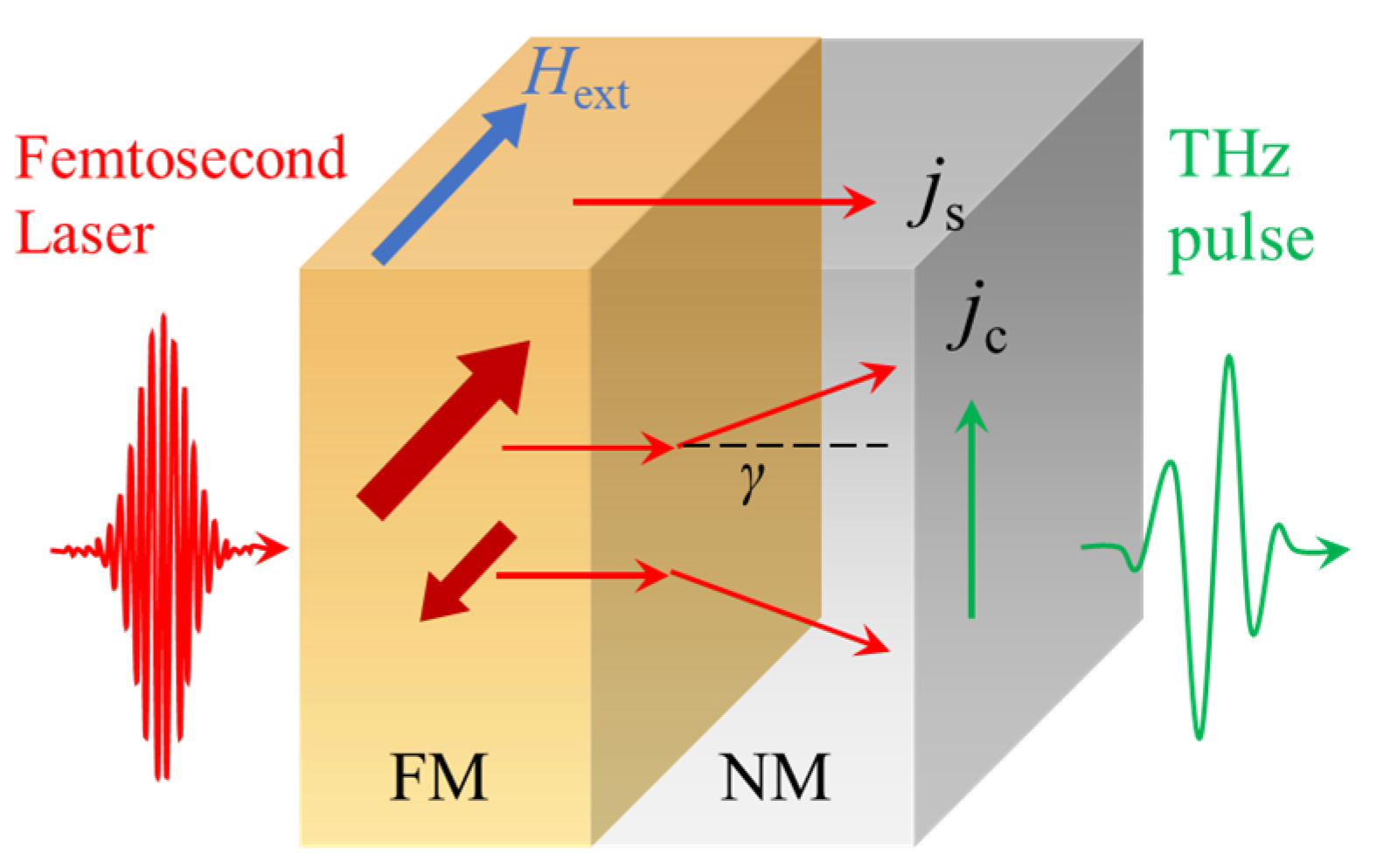
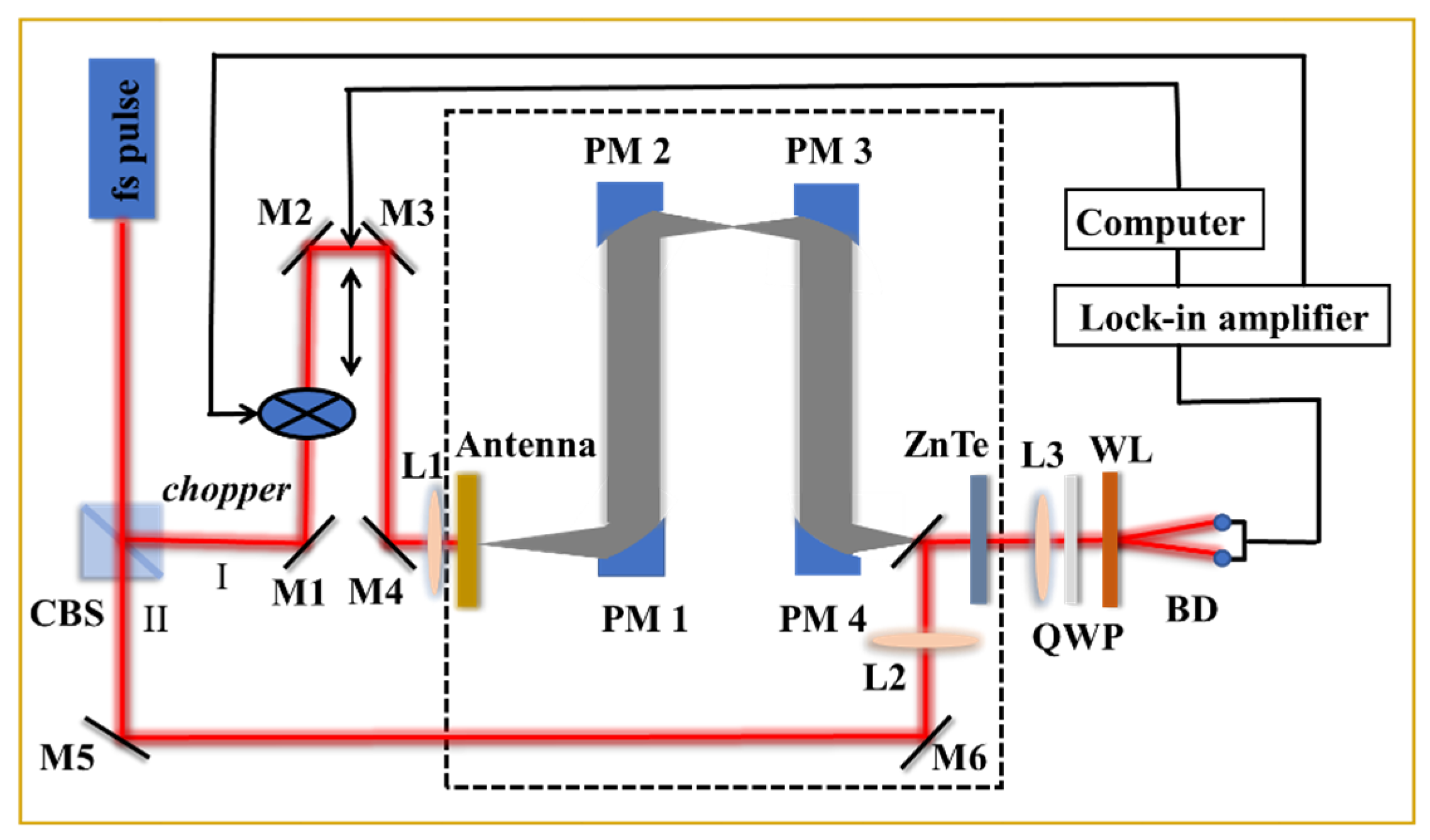
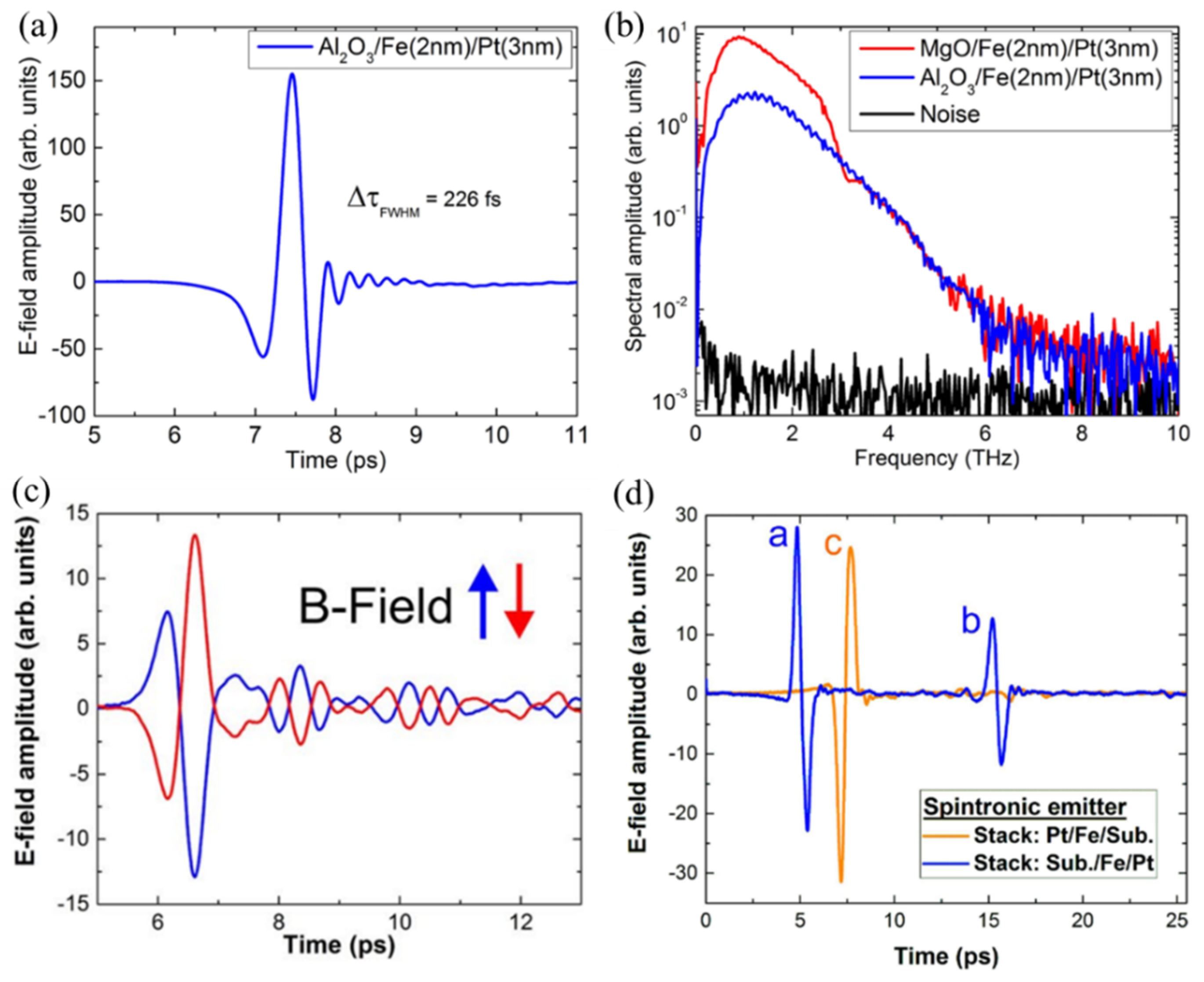
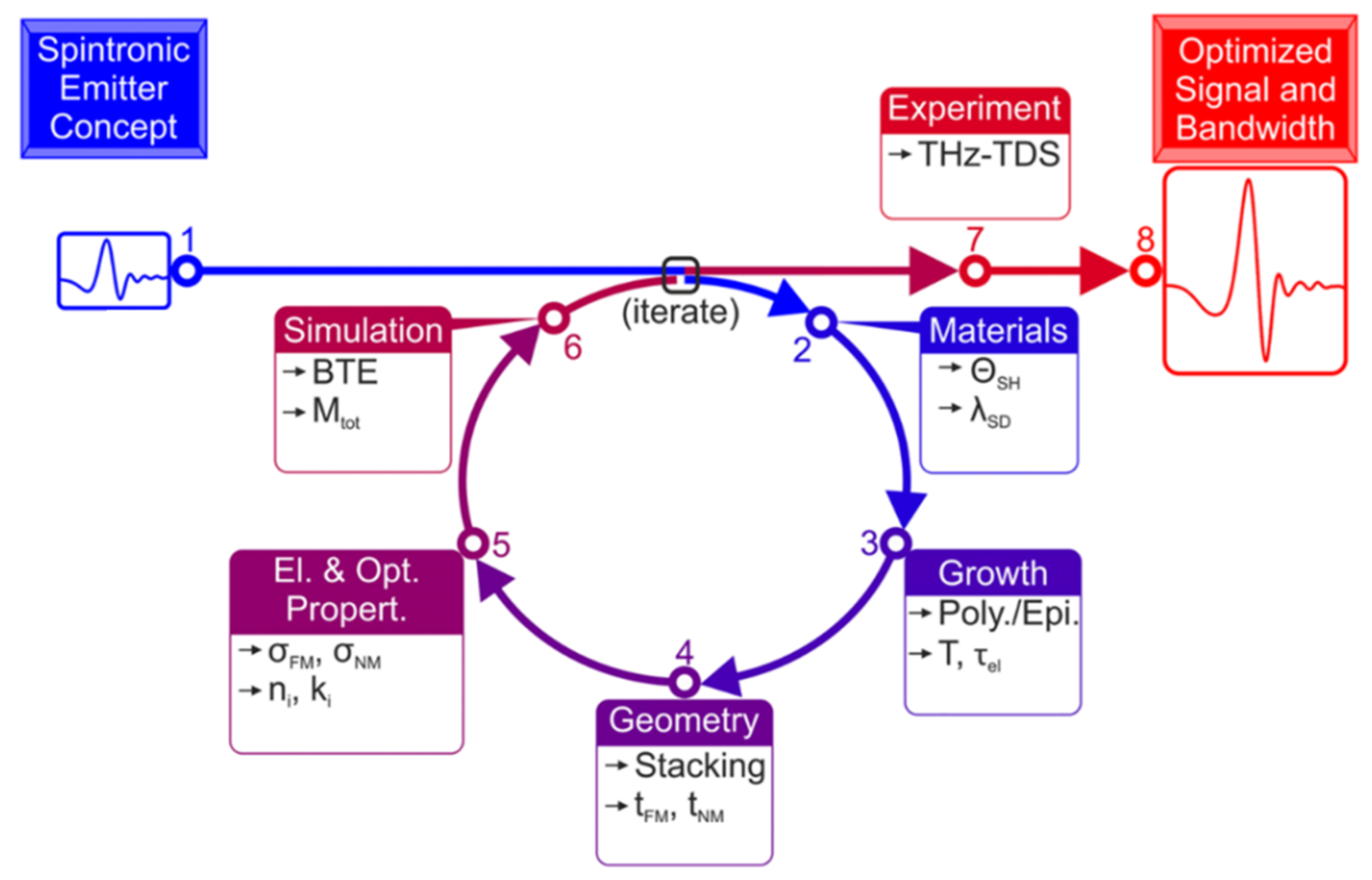

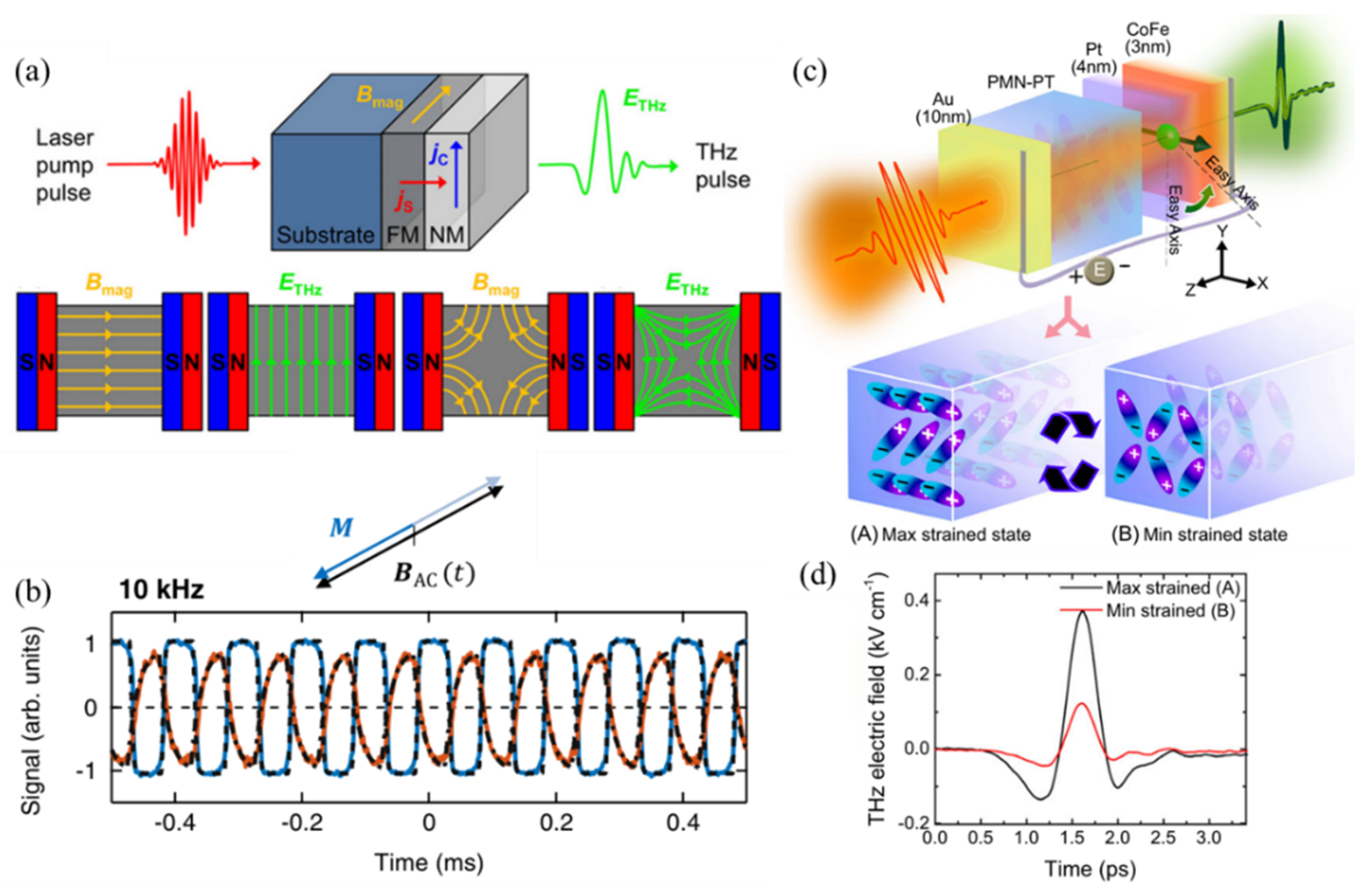
Publisher’s Note: MDPI stays neutral with regard to jurisdictional claims in published maps and institutional affiliations. |
© 2022 by the authors. Licensee MDPI, Basel, Switzerland. This article is an open access article distributed under the terms and conditions of the Creative Commons Attribution (CC BY) license (https://creativecommons.org/licenses/by/4.0/).
Share and Cite
Wang, M.; Zhang, Y.; Guo, L.; Lv, M.; Wang, P.; Wang, X. Spintronics Based Terahertz Sources. Crystals 2022, 12, 1661. https://doi.org/10.3390/cryst12111661
Wang M, Zhang Y, Guo L, Lv M, Wang P, Wang X. Spintronics Based Terahertz Sources. Crystals. 2022; 12(11):1661. https://doi.org/10.3390/cryst12111661
Chicago/Turabian StyleWang, Maorong, Yifan Zhang, Leilei Guo, Mengqi Lv, Peng Wang, and Xia Wang. 2022. "Spintronics Based Terahertz Sources" Crystals 12, no. 11: 1661. https://doi.org/10.3390/cryst12111661
APA StyleWang, M., Zhang, Y., Guo, L., Lv, M., Wang, P., & Wang, X. (2022). Spintronics Based Terahertz Sources. Crystals, 12(11), 1661. https://doi.org/10.3390/cryst12111661




